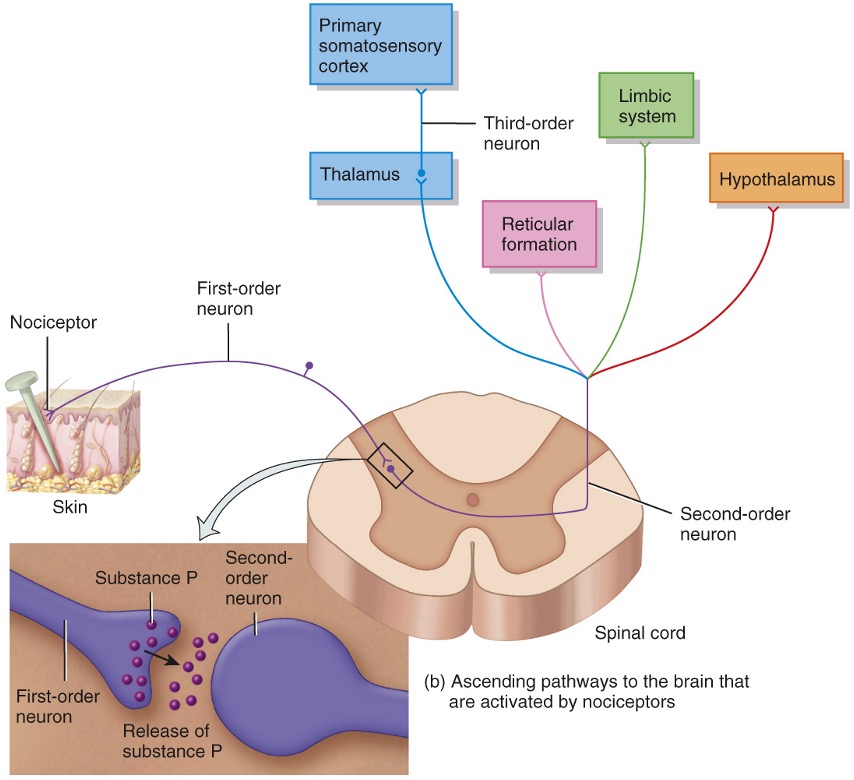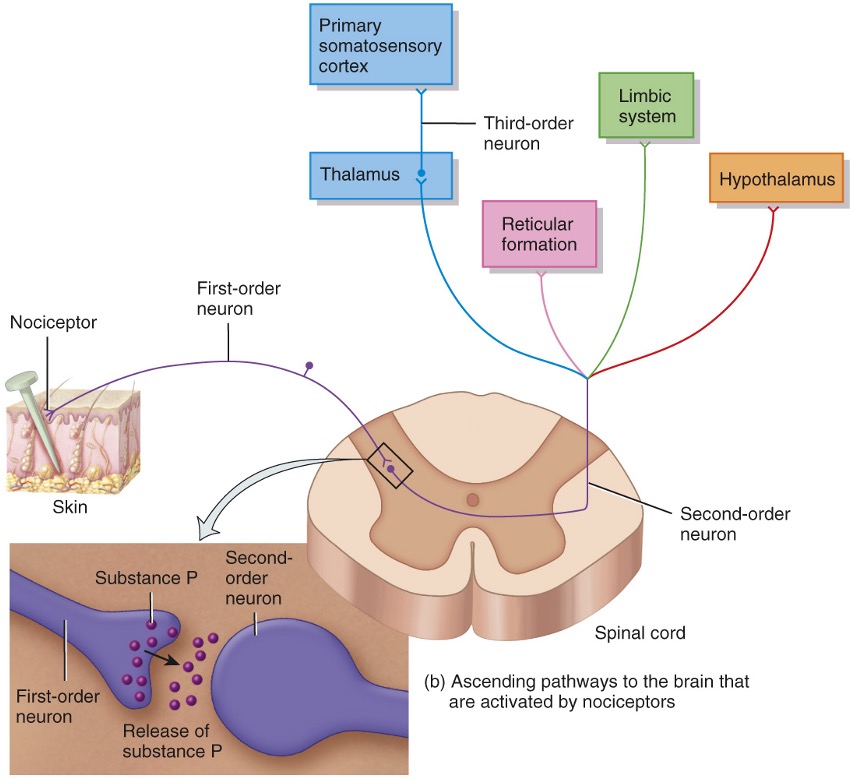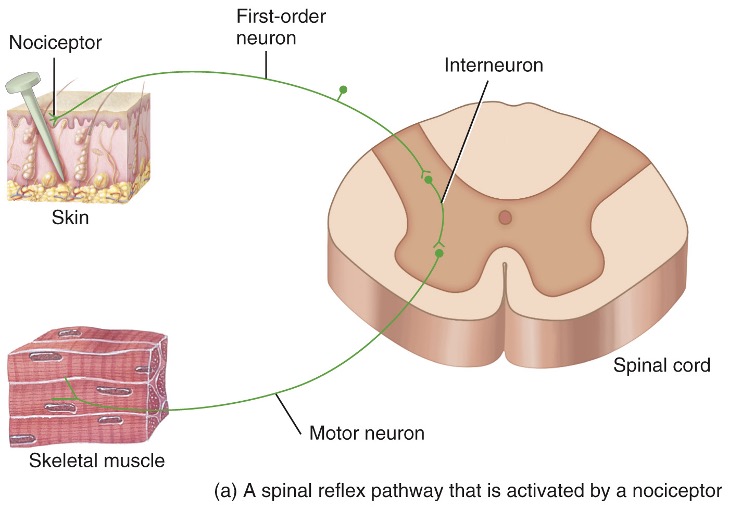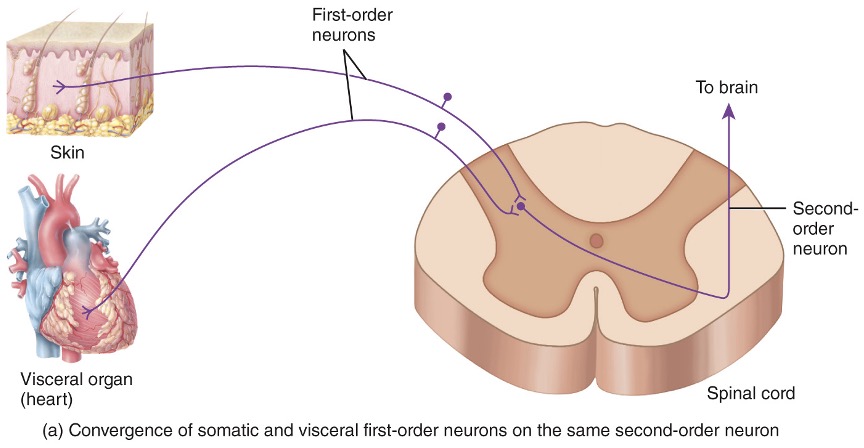sensory systems - pain pathways
1/9
There's no tags or description
Looks like no tags are added yet.
Name | Mastery | Learn | Test | Matching | Spaced |
|---|
No study sessions yet.
10 Terms
nociceptors and their adequate stimuli
nociceptors, the receptors for pain, are free nerve endings found in every tissue of the body except the brain and spinal cord
three types of nociceptors
(1) mechanical nociceptors: which respond to intense mechanical stimuli, such as a pinch or puncture
(2) thermal nociceptors: which respond to extreme thermal stimuli such as temperatures above 45°C or below 10°C; and (3) polymodal nociceptors: which respond to a variety of stimuli, including intense mechanical stimuli, extreme thermal stimuli, and chemicals released from damaged tissue
transduction in a nociceptor
transduction in nociceptors involves cation channels that open in response to noxious stimuli
Ex: TRPV1† - a member of the transient receptor potential (TRP) vanilloid subfamily
TRPV1 channels are found in the membrane of a polymodal nociceptor (Figure 9.14).
they are cation channels that open in response to extreme heat or to capsaicin—the ingredient that makes chili peppers painfully hot
opening these cation channels allows Na+ and Ca2+ ions to enter the nociceptor, which causes a depolarizing receptor potential to form in the nociceptor’s membrane
if threshold is reached, an action potential is generated in the axon of the sensory neuron.
fast and slow pain
There are two types of pain: fast and slow
fast pain: sharp, pricking sensation that is well localized
ex: the pain felt from a needle puncture or a knife cut to the skin is fast pain; signals for fast pain are transmitted along A-delta (Aδ) fibers (small, myelinated axons with conduction velocities ranging from 12 to 30 m/sec);
sensory neurons associated with mechanical or thermal nociceptors have Aδ fibers and are the source of the signals for fast pain
slow pain: by contrast, is a dull, aching sensation that is poorly localized.
ex: is the pain associated with a minor toothache. Signals for slow pain are transmitted along C fibers (small, unmyelinated axons that have conduction velocities ranging from 0.5 to 2 m/sec)
sensory neurons associated with polymodal nociceptors have C fibers and are the source of the signals for slow pain.
anterolateral pathway
conscious awareness of pain sensation
this is an ascending pathway; ascending pathways to the brain that are activated by nociceptors allow pain information to be processed by higher centers
this pathway conveys input from nociceptors to the cerebral cortex via relays in the spinal cord and thalamus. This pathway is responsible for conscious awareness of pain sensations

reticular formation
the pathway to the reticular formation increases your level of arousal in response to a painful stimulus
limbic system
the pathway to the limbic system causes the emotional responses (fear, anxiety, etc.) that may occur after a painful experience
hypothalamus
the pathway to the hypothalamus elicits the autonomic responses (increased heart rate, sweating, etc.) that may accompany a painful incident
pain pathways
description of image
activation of first-order neurons of a given pain pathway causes the release of neurotransmitters that influence the activity of nearby postsynaptic neurons
the two main neurotransmitters released from first-order pain neurons are glutamate and the neuropeptide substance P
once glutamate and substance P are released, they activate the next neurons of the pain pathway

spinal reflex pathway
spinal reflex pathways that are activated by nociceptors provide unconscious protective responses when a noxious stimulus begins to damage the body
ex: stepping on a tack or touching a hot burner on the stove elicits the flexor reflex, which quickly withdraws the affected limb away from the painful stimulus
muscles are focused on removing the limb + happens quickly

somatic + visceral + referred pain
somatic pain: arises from stimulation of nociceptors in skin, skeletal muscles, and joints
superficial somatic: skin pain
deep somatic: arises in muscles, joints, tendons
visceral pain: results from stimulation of nociceptors in visceral (internal) organs.
in many instances of visceral pain, the pain is felt at a site other than the place of origin
ex: the pain of a heart attack typically is felt in the skin over the heart and along the left arm
this phenomenon is called referred pain
referred pain: occurs because both somatic sensory and visceral sensory neurons often converge on second-order neurons of the same ascending pathway to the brain
pain that is felt at a location that was not the origin of the pain
occurs bc the neurons converge on the same 2nd order neuron
